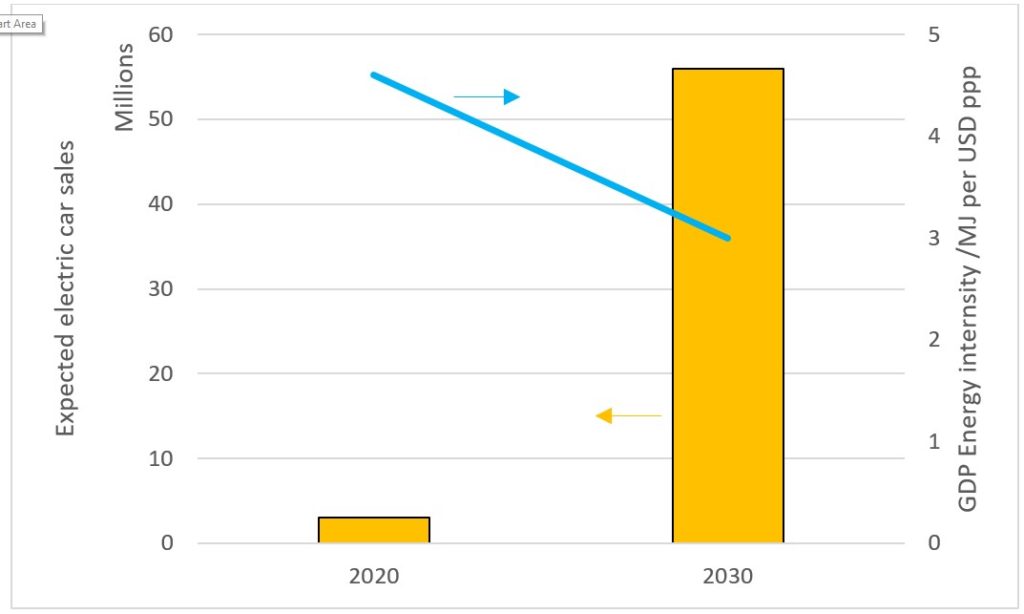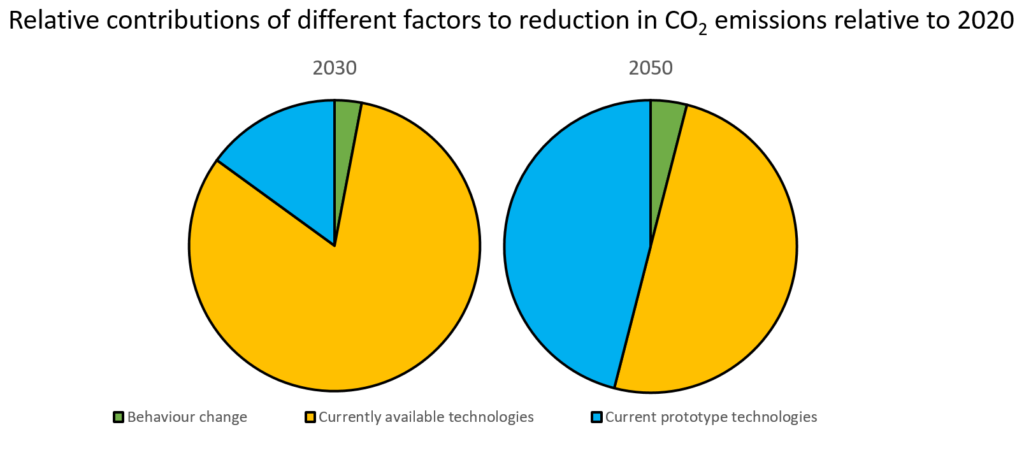24/05/2021
Last week, amid unseasonably windy and wet weather in the UK, National Grid reported a new record share of electricity demand being produced by wind turbines (62.5 %) throughout Great Britain. In a timely coincidence, in the same week, the International Energy Agency (IEA) released a fascinating report on how a net zero (emissions) energy system may be achieved globally by 2050.
The report provides a roadmap providing a narrow but achievable path to a global “net zero” energy system based on technologies including renewable such as solar and wind, bioenergy, and carbon capture, and behaviour changes.
In the following, we concentrate on the technological aspects of the report. At Reddie & Grose, we have experience helping inventors and developers in sustainable energy technologies. In particular, we have experts who specialise in improved combustion engines, electric engines, future transport systems including batteries and fuel cells, and renewables such as solar, wind, and biofuels as well as improved oil and gas extraction.
Over the next 30 years, disruptive technologies must make an increasing contribution
While the IEA assumes that most of the reduction in CO2 emissions until 2030 must come from significant investment into current technologies, such as renewables, electric vehicles and energy efficient buildings, by 2050, they expect nearly half the emission savings to be achieved by technologies currently in the prototype phase.
This signals that to achieve net zero by 2050, which is a goal of an increasing number of governments around the world and looks set to be a key topic at COP2026 in Glasgow, significant investments will have to be made into products at various levels of development. This opens opportunities for inventive companies both in more mature technologies (looking for incremental improvements) and areas where technologies are currently at the prototype stage (looking for disruptive development).
By 2040, the IEA figures that renewable electricity generation should cover about half of the total global energy consumption. This requires significant research and development in some “ancillary” technologies to provide flexibility to the electricity system – the report mentions batteries, hydrogen fuels, and hydropower.
By 2045, the IEA report assumes that new, currently underdeveloped, technologies will be widespread and contribute to reducing net carbon dioxide emissions. According to the roadmap, by 2045, almost all cars will be running on batteries or fuel cells, planes will rely on advanced biofuels, and carbon capture and storage or hydrogen fuels will reduce emissions from industrial plants.
Key solutions
According to the IEA, a few key solutions will be particularly important for achieving net zero. While most of the solutions highlighted by the report will not come as a surprise to interested parties, we expect to see increasing patenting activity in these fields as proliferation of each of these key technologies increases.
- Renewables: by 2050, solar and wind are predicted to grow to providing 70% of global electricity, making the single largest source of CO2 emissions more sustainable;
- Energy efficiency: reducing carbon emissions in existing technologies by making them more energy efficient is set to significantly reduce CO2 emissions in the near term – the IEA focuses on reduced fuel consumption of heavy trucks and improved buildings, appliances, and industrial production;
- Electrification: electrification of sectors and technologies currently using fossil fuels will contribute significantly to net-zero by 2050, in particular by increasing the share of electric buses, cars, and trucks (resulting in massive increases in annual battery demand) and increasing use of heat pumps;
- Bioenergy: sustainable bioenergy will reduce emissions from planes and ships (where batteries are unlikely to be a workable alternative), and replace fossil fuels in heating, electricity generation, and cooking.
- CCUS: Carbon capture, utilisation, and storage will be essential in the production of products such as cement and aluminium, where emissions are difficult to reduce;
- Hydrogen and hydrogen based fuels: some sectors, including shipping and planes, are unlikely to become electrified by 2050, and bioenergy supply is unlikely to be sufficient to supply these sectors. As such, low carbon fuels such as hydrogen and hydrogen based fuels may have to contribute significantly to reaching net zero by 2050.
The technologies that the IEA believe to hold the biggest opportunities
While the IEA highlights some broad key solutions, they also point to a set of three key technology areas which they believe will make some of the most significant contributions to the reduction in CO2 emissions between 2030 and 2050, i.e. once the currently available technologies have been more broadly deployed.
We have highlighted each of these three key technology areas in previous insight articles:
- Advanced batteries (discussed here);
- Hydrogen electrolysers (discussed here);
- Direct air capture and storage (discussed here).
Some of the most striking numbers
The IEA report contains many interesting and thought-provoking statistics, and we recommend anyone interested to look at the full 224 page report. Some of the most striking numbers are highlighted below.
Figure 1 shows the massive predicted growth in electric car sales between 2020 (3 million) and 2030 (56 million). This growth will come with significant further investment and development in electric vehicle technology, and all associated technologies (including batteries, charging infrastructure, etc.). At the same time, it is predicted that the energy intensity of GDP, long believed to require energy demand to increase for GDP to grow, to decrease between 2020 and 2030.

Figure 1: Expected electric car sales in millions on the left (orange) in 2020 and 2030; Energy intensity in MJ required per USD ppp of GDP generated
Figure 2 highlights the different factors that will contribute to the reduction in CO2 emissions in 2030 and in 2050. While behaviour change is expected to make only modest contributions, technologies currently on the market are expected to contribute about 82 % of CO2 savings in 2030. However, by 2050, the more disruptive, current prototype technologies, are expected to contribute more significantly (46 %) to CO2 saving by 2050.

Figure 2: Relative contributions to CO2 savings in 2030 and 2050 by behaviour change, technologies currently on the marked, and technologies currently at prototype stage.
Summary
This new IEA report highlights that there is a narrow but realistic path to a global net zero emissions energy system by 2050. Achieving net zero will require significant investment, and innovation, in technologies currently on the market and disruptive technologies currently in the various stages of prototyping.
The IEA report points out a few key solutions for CO2 savings, including renewables, energy efficiency, electrification, bioenergy, carbon capture, and hydrogen. It further defines three key technology areas which will underscore some of these key solutions, including advanced batteries, hydrogen electrolysers, and direct air capture.
As patent attorneys, we are always fascinated by innovation, and we will therefore continue to follow any new developments in these technologies closely. We are experienced at supporting our clients protect their inventions in these planet-friendly technologies, so please do not hesitate to contact us if you would like help patenting your inventions.
This article is for general information only. Its content is not a statement of the law on any subject and does not constitute advice. Please contact Reddie & Grose LLP for advice before taking any action in reliance on it


